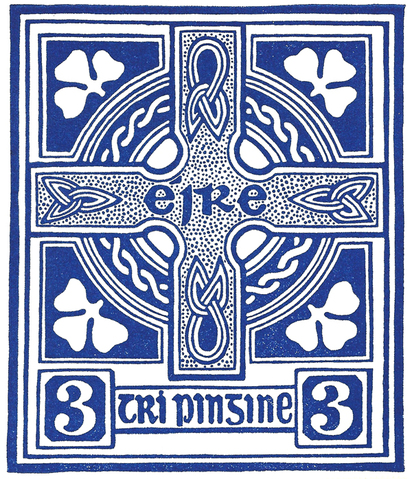Eire: Celtic Cross
|
Provenance:
Paper Type: Rives Lightweight Buff, 115 gm/m2 Paper Size: 10" x 13" [25.4cm x 33cm] Image Size: 4" x 5" [10.2cm x 12.7cm] Edition Size: 50 Date: 14 Jan 2013 Inks used: Van Son Rubber Based Inks Production Notes: I scanned an Irish postage stamp [Scott #70] then printed a reversed copy onto parchment paper [Bienfang No. 100] and glued this onto the linoleum block using Photo Mount [3M No. 6092]. I cut directly through the paper using stencil cutters under a stereo dissecting microscope [Bausch & Lomb 13x’] and printed as a collage with a replica stamp glued [UHUstic Baton de colle] in the lower right corner. |
Ireland for many years was a very reluctant participant of the British Empire. During the 19th century when the empire was at its peak, Irish rebels waged a war of sabotage against British interests on the island. In the early years of the 20th century one of the more effective nationalist organizations, Sinn Féin, issued a propaganda postage label, a Celtic Cross flanked at the cardinal axes with shamrocks over a base of ornamental designs taken from early Irish manuscripts. Not valid for postage, the use of these labels as postal stamps was sternly forbidden by Post Office regulations.
After WWI separatists fought a War of Independence between the Irish Republic and the British government, ended by the Anglo-Irish Treaty of 6 December 1921. Under this treaty the lower 26 counties became an autonomous dominion of the British Empire with the British monarch as head of state, in the same manner as Canada and Australia. The remaining six northeastern counties remained a part of the United Kingdom as Northern Ireland. The first definitive postage stamps issued by the newly independent nation in 1922 included one which resurrected the Sinn Féin label, adding a Gaelic denomination caption, "tri pingine" or three pence [Scott #70 printed in ultramarine blue]. The design was reissued in 1941 [Scott #111, dull blue] and 1967 [Scott #225, blue] with variations of print dimensions, perforations and watermarks. As a linoleum block design this stamp was devilishly hard to cut. Each dot in the Celtic Cross had to be incised separately, a task requiring many hours of work under strong magnification. Available:
$25.00 USD $500 MXN Shipping: $15.00 with tracking to USA |

